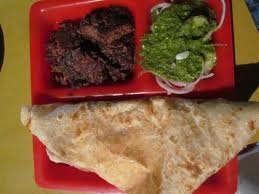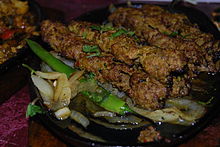
Kebab, kabob, kebap, or kabab (Kashmir) is roasted meat that originates from the Middle East. Many variants of the category are popular around the world, including the skewered shish kebab and the doner kebab with bread.

Pakistani cuisine can be characterized as a blend of regional cooking styles and flavours from across South, Central and Western Asia. Pakistani cuisine is influenced by Persian, Indian, and Arab cuisine. The cuisine of Pakistan also maintains certain Mughal influences within its recipes and cooking techniques. Pakistan's ethnic and cultural diversity, diverse climates, geographical environments, and availability of different produce lead to diverse regional cuisines.

Chelow kabab is an Iranian dish consisting of steamed rice and one of the many varieties of Iranian kebab. It is considered the national dish of Iran, and was probably created by the time of the Qajar dynasty.

Chicken tikka is a chicken dish popularised in the Indian subcontinent popular in India, Bangladesh, Pakistan and the United Kingdom. It is traditionally small pieces of boneless chicken baked using skewers on a brazier called angeethi or over charcoal after marinating in Indian spices and dahi (yogurt)—essentially a boneless version of tandoori chicken. The word tikka is a Persian word, meaning "bits" or "pieces". It is also a chicken dish served in Punjabi cuisine. The Kashmiri version of the dish, however, is grilled over red-hot coals, and does not always contain boneless pieces. The pieces are brushed with ghee at intervals to increase its flavour, while being continuously fanned. It is typically eaten with green coriander and tamarind chutney served with onion rings and lemon, or used in preparing an authentic chicken tikka masala.

Shami kabab or shaami kabab is a local variety of kebab, originating from the Indian subcontinent. It is a popular dish in modern-day Indian, Pakistani and Bangladeshi cuisines. It is composed of a small patty of minced meat, generally beef, but occasionally lamb or mutton, with ground chickpeas, egg to hold it together, and spices. Shami kebab is eaten as a snack or an appetizer, and is served to guests especially in the regions of Dhaka, Deccan, Punjab, Kashmir, Uttar Pradesh and Sindh.

Shish kofta (Turkish) is a type of kebab-style kofta dish in Turkish cuisine.

Kabab koobideh or Kobide is an Iranian type of kofta kabab made from ground lamb or beef, often mixed with ground pepper and chopped onions.

Shish taouk or shish tawook is a traditional marinated chicken shish kebab of Ottoman cuisine that later became part of Middle Eastern cuisine. It is widely eaten in the Middle East and Caucasus. A similar dish in Persian cuisine is the traditional jujeh kabab. It is also served in kebab houses in many cities around the world.

Jujeh kabab is an Persian dish that consists of grilled chunks of chicken which are sometimes with bone and other times without bone. It is one of the most common and popular dishes of Iran. It is common to marinate the chunks in minced onion, lemon juice and saffron.

Shish kebab or shish kebap is a popular meal of skewered and grilled cubes of meat. It can be found in Mediterranean cuisine and is similar to or synonymous with dishes called shashlik and khorovats, found in the Caucasus region.

Many regional cuisines feature a mixed grill, a dish consisting of an assortment of grilled meats.

Mughlai cuisine consists of dishes developed or popularised in the early-modern Indo-Persian cultural centres of the Mughal Empire. It represents a combination of cuisine of the Indian subcontinent with the cooking styles and recipes of Central Asian and Islamic cuisine. Mughlai cuisine is strongly influenced by the Turkic cuisine of Central Asia, the region where the early Mughal emperors originally hailed from, and it has in turn strongly influenced the regional cuisines of Northern India, Pakistan and Bangladesh.
Awadhi cuisine is a cuisine native to the Awadh region in Northern India and Southern Nepal. The cooking patterns of Lucknow are similar to those of Central Asia, the Middle East, and Northern India and western India with the cuisine comprising both vegetarian and non-vegetarian dishes. The Awadh region has been influenced by Mughal cooking techniques, and the cuisine of Lucknow bears similarities to those of Central Asia, Kashmir, Punjab and Hyderabad. The city is also known for its Nawabi foods.
Bihari cuisine is eaten mainly in the eastern Indian state of Bihar, as well as in the places where people originating from the state of Bihar have settled: Jharkhand, Eastern Uttar Pradesh, Bangladesh, Nepal, Mauritius, South Africa, Fiji, some cities of Pakistan, Guyana, Trinidad and Tobago, Suriname, Jamaica, and the Caribbean. Bihari cuisine includes Angika cuisine, Bhojpuri cuisine, Maithil cuisine and Magahi cuisine.

Pashtun cuisine refers to the cuisine of the Pashtun people and is covered under both Afghan and Pakistani cuisines. It is largely based on meat dishes including mutton, beef, chicken, and fish as well as rice and some other vegetables. Accompanying these staples are dairy products, various nuts, local vegetables, and fresh and dried fruits. Peshawar, Islamabad, Kabul, Bannu, Quetta, Kandhar and Mardan are centers of Pashtun cuisine.

Chapli kebab or chapli kabab is a Pashtun-style minced kebab, usually made from ground beef, mutton or chicken with various spices in the shape of a patty. The chapli kabab originates from Peshawar in Pakistan. The Peshawari chapli kabab is made with beef and is a popular street food throughout South Asia, including Pakistan, Afghanistan and Bangladesh.

Tunday Ke Kabab, also known as Galouti kebab, is a dish made out of minced meat which has almost become synonymous with the city of Lucknow, India. It is a part of Awadhi cuisine. It is said to incorporate 160 different spices. Ingredients include finely minced buffalo meat, plain yogurt, garam masala, grated ginger, crushed garlic, ground cardamom, powdered cloves, melted ghee, dried mint, small onions cut into rings, vinegar, saffron, rose water, sugar, and lime. Tunday Ke Kabab were introduced to the Nawab of Awadh Wajid Ali Shah. Lucknow’s iconic eating joint Tunday Kababi, started in 1905, is famous for serving buffalo meat galouti kebab.
















